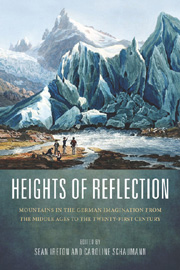 Heights of Reflection
Heights of Reflection Book contents
- Frontmatter
- Contents
- Acknowledgments
- Introduction: The Meaning of Mountains: Geology, History, Culture
- Prelude: Classical Mountain Landscapes and the Language of Ascent
- Part I First Forays: Mountain Exploration and Celebration from the Middle Ages to the Eighteenth Century
- Terra Incognita? Mountains in Medieval and Early Modern German Literature
- From Meadows to Mountaintops: Albrecht von Haller's “Die Alpen”
- Interlude: Geo-Poetics: The Alpine Sublime in Art and Literature, 1779–1860
- Time and Narrative in the Mountain Sublime around 1800
- Faust's Mountains: An Ecocritical Reading of Goethe's Tragedy and Science
- Spectacular Scenery and Slippery Descents: Narrating the Mountains of Tropical Polynesia
- Part II Beckoning Heights: Summits Near and Far in the Nineteenth Century
- Part III Modern Expeditions and Evocations: Climbing from the Twentieth into the Twenty-First Century
- Works Cited
- Notes on the Contributors
- Index
Interlude: Geo-Poetics: The Alpine Sublime in Art and Literature, 1779–1860
from Part I - First Forays: Mountain Exploration and Celebration from the Middle Ages to the Eighteenth Century
Published online by Cambridge University Press: 05 February 2013
- Frontmatter
- Contents
- Acknowledgments
- Introduction: The Meaning of Mountains: Geology, History, Culture
- Prelude: Classical Mountain Landscapes and the Language of Ascent
- Part I First Forays: Mountain Exploration and Celebration from the Middle Ages to the Eighteenth Century
- Terra Incognita? Mountains in Medieval and Early Modern German Literature
- From Meadows to Mountaintops: Albrecht von Haller's “Die Alpen”
- Interlude: Geo-Poetics: The Alpine Sublime in Art and Literature, 1779–1860
- Time and Narrative in the Mountain Sublime around 1800
- Faust's Mountains: An Ecocritical Reading of Goethe's Tragedy and Science
- Spectacular Scenery and Slippery Descents: Narrating the Mountains of Tropical Polynesia
- Part II Beckoning Heights: Summits Near and Far in the Nineteenth Century
- Part III Modern Expeditions and Evocations: Climbing from the Twentieth into the Twenty-First Century
- Works Cited
- Notes on the Contributors
- Index
Summary
There is nothing in Nature more shapeless and ill-figur'd than an old Rock or Mountain.… They are the greatest Examples of Confusion that we know in Nature; no Tempest or Earthquake puts things into more Disorder.” This account of the Alps by Thomas Burnet in The Sacred Theory of the Earth (1684) typifies seventeenth-century impressions of mountains as spectacles of horror and chaos, or as excrescences of a cursed upheaval consequent to the expulsion from Eden. In Milton's Paradise Lost (1667) the fallen angels roam an infernal Alpine topology:
Through many a dark and dreary dale
They pass'd, and many a region dolorous
O'er many a frozen, many a fiery alp;
Rocks, caves, lakes, fens, bogs, dens, and shades of death.
More equivocal post-medieval imaginations had fathomed mountains either as abyssal diabolic chasms or holy summits for ascetic purification. From mountain purgatories to John Ruskin's notion of Alpine paradiso terrestre there is a radical perceptual and conceptual leap. The pinnacles that are in Ruskin's redaction “the beginning and the end of all natural scenery” affirm vertiginous virtue in the scale of the beauty and moral quality of art, architecture, and society. His aesthetics of the Alpine sublime may be summed up in the architectonic formula: “Mountains are the cathedrals of the earth.”
- Type
- Chapter
- Information
- Heights of ReflectionMountains in the German Imagination from the Middle Ages to the Twenty-First Century, pp. 77 - 97Publisher: Boydell & BrewerPrint publication year: 2012


